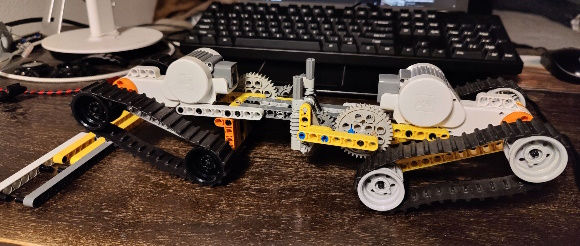The Making of a Custom 3D Printed Dropper Lever (V1)
- Jerry Wang

- Jul 30, 2019
- 4 min read
Updated: Jun 27, 2020
Problem Identified
I got a secondhand mountain bike. After the new bike excitement wore off, I started to notice problems on this bike. The main one being the dropper post lever. For those who don't know what this is, I'll explain:
A dropper post is a seatpost that goes up and down with the actuation of a lever, much like an office chair. This feature allows riders to climb up hill efficiently with the seat up, and the get the seat out of the way quickly during descents so the rider can be more agile.
This lever that came with this bike felt really difficult to actuate, and flexes a lot when I press onto it. My efforts to lubricate the cable housing did not help either.
The problem with this lever is that the metal piece that the lever pivots on is very thin, it has already been bent just from regular uses. Besides that, there is a spring that is sandwiched between the lever and the body, adding more slack to the assembly. Lastly, the interface that mounts the body to the clamp is poorly designed, a simple lever press action produced so much torque, the force that is exerted onto that interface deformed the aluminum.
There are of course off-the-shelf solutions to this, simply buying a better, more expensive replacement. After some consideration, however, I deemed simply buying a new lever is not worth it. The lever performs a very simple function, pulling a cable by the actuation of a thumb. Current higher-end levers cost around 50-60 dollars. Those incorporate a bearing at the pivot to allow smooth actuation, and less slop in the system. They are also made of machined aluminum, which is probably the primary reason why they are priced so high, besides the factor of this being a niche market.
Goals, Requirements, and Design
I recently acquired a 3D printer, inspired by my experience working on the animatronic dolphin. Considering that this application is not a high performance part, I decided that making a fully custom lever of my own by FDM is viable, and can cut down the cost drastically, while performing similarly to levers that are within the 50-60 dollar range.
I identified a list of features and design requirements that would allow my design to match up against those on the market:
Bearing pivot for smooth actuation while taking out the slop.
Thicker construction since the material I'm working with is plastic filament.
Linear actuation (many higher end levers have this feature for enhanced feel).
Gotta look cool!
With these factors in mind, I made a few sketches, and finally came up with something I think's I'd be happy with.
I designed the lever to be water drop shaped for rigidity; the circular end that the cable rests on provided a constant actuation ratio, improving the feel of the lever. The body of the lever is very basic; it continues the geometric theme of the lever. There are only four parts that are designed to be plastic, and the rest are standard hardware that can be easily found in hardware stores. I did not use a spring in this design, since the cable does have spring-back action provided by the dropper post's mechanism, so a spring is quite unnessary.
After the sketch phase, I modeled it in SolidWorks, and figured out the exact dimentions by just taking measurements of the diameter of the handlebar, hardware, and the bearing to be used, which is a standard 608.

Build
Relying on my memories from working on the animatronic dolphin, I exported the SolidWorks file and configured the printer similarly to Sebastian's printer. The prints came out quite good.

The above picture shows the body of the lever, which connects the lever to the handlebar, and holds the cable housing so the lever can pull the cable. The bearing responsible for pivoting simply gets pressed into it. A M5 bolt that goes through a centering spacer (3d printed) then drops through the bearing and threads into the lever part. The bolt also acts as structural enhacement to the lever, making it much more difficult to fail.

Then everything is put together and installed onto my bike. I designed the clamp to be an open clamp secured by two bolts, that way I do not have to take the grip off to slide it onto the bar. It would reduce the part count to use a single bolt pinch clamp, but I didn't see it as a good feature also for another reason. Since FDM works by depositing layers, I wanted the layer lines in the upper clam to have an orientation that is parallel to the force applied by the two pinch bolts so the part won't split along the layer lines. I printed the upper clamp side ways to ensure the laminate direction is also along the force direction. Over time, this proved to work well because the clamp never gave out despite only having a thickness of 2 mm.
Functioning
So far the lever has works flawlessly for many rides, but I'm still somewhat unhappy with the shape of the lever, so I would probably work on a version two, with enhanced performance and better aesthetics.
















Comments